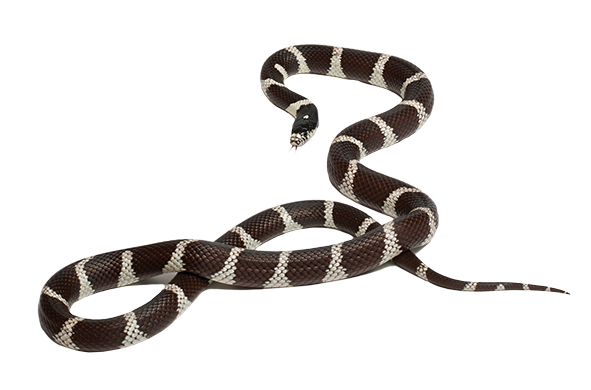
California Kingsnake

Please see copyright notice below.
Report sightings
Complete the Report an unusual animal sighting form or;
Phone: 1800 680 244
Email: invasive.species@dpi.nsw.gov.au
Origin
The California kingsnake (Lampropeltis getula californiae) is native to southwestern USA and northwestern Mexico. Kingsnakes are one of the most widespread snake species in the USA.
Description
California kingsnakes are around 20-25 cm in length when they hatch.The average size of an adult snake is approximately 75-120 cm in length. They have smooth, shiny scales and the head is barely wider than the neck.
Depending on their origin, kingsnakes have many different patterns and colour variations. The most common and easily recognised pattern is banding; usually light-coloured bands on a darker background. They have many colour variations from black and white to brown and cream or shades of yellow.
Impacts
California kingsnakes have been bred and actively distributed by the international pet industry with the species now kept both legally and illegally in captivity around the world.
This primarily terrestrial snake can live in a wide range of habitats, including forest, grassland, semi-desert, desert and farmland. The species has become established in Gran Canaria (a Spanish island off the coast of Morocco) where they are having devastating effects on the native wildlife of the area. The species has the potential to establish in NSW and to compete for habitat and food, as well as prey on our native species. As with most exotic species they also pose a disease and parasite risk to the native fauna of Australia.
Kingsnakes have a generalist diet and will consume warm-blooded prey such as rodents and birds, as well as cold-blooded prey such as lizards and frogs (in addition to other snakes). This non-selective diet has the potential to pose a serious threat to Australian native wildlife.
Feeding
California kingsnakes will eat just about any animal small enough to be overpowered and swallowed whole, including other snakes. Since they do not produce venom, kingsnakes use constriction to subdue their prey. Kingsnakes are active hunters, seeking out their prey.
Breeding
California kingsnakes lay eggs. Female California kingsnakes reach maturity at 3-4 years and can live up to 20 years. Courtship behaviour between a male and a female involves neck-biting to hold the female during copulation. One to two months after mating females lay an average clutch size of 8-10 eggs which hatch in 6-8 weeks (earlier in warmer temperatures and later in cooler temperatures).
Legislation
The California kingsnake has been bred for the pet industry and is now kept both legally and illegally in captivity around the world. In Australia, the importation of live animals is controlled by the Environment Protection and Biodiversity Conservation Act 1999 (EPBC Act) and the Biosecurity Act 2015 (Cth).
There are restrictions on the animals that can be imported into Australia. These restrictions have been established as a safeguard to protect Australia against exotic pests and diseases that are considered a threat to the Australian environment, economy and the wider community and to protect endangered species from uncontrolled trade which can lead to population decline and extinction of endangered species. For these reasons the California kingsnake is prohibited from importation to Australia.
The illegal importation of wildlife often leads to animal cruelty issues due to the efforts made by smugglers to avoid detection of the animals during the importation process. As a consequence, smuggled animals can suffer stress, dehydration and starvation and many smuggled animals die during or as a result of the smuggling process.
The California kingsnake is classified as a Prohibited Dealing under the NSW Biosecurity Act 2015 making it an offence to keep the species in NSW.
Copyright notice
The following notice applies to the images (above) owned by NSW Department of Primary Industries (DPI):
DPI photographs from this photo gallery may be reproduced and used for in-house, educational and non-commercial purposes without further permission.
You must obtain separate permission to use the photographs for advertising, commercial promotion or any other commercial purpose.
Please acknowledge the source of the photograph as given in the caption, or in the absence of any other attribution, acknowledge NSW Department of Primary Industries.

